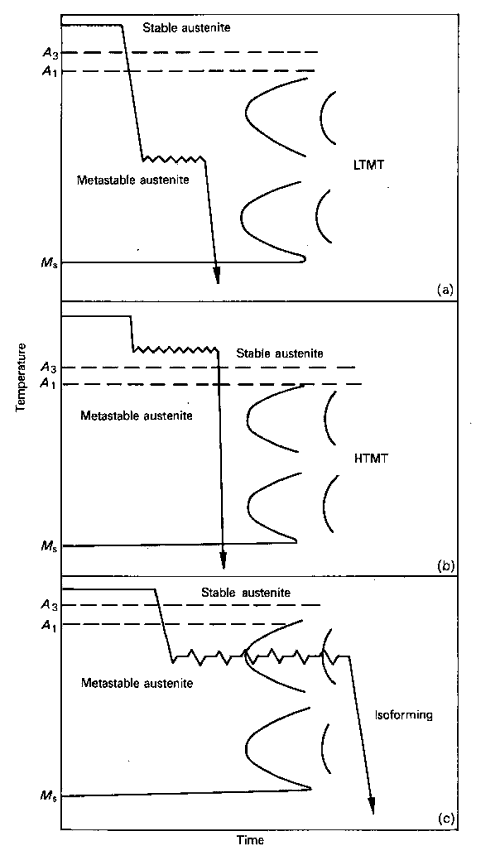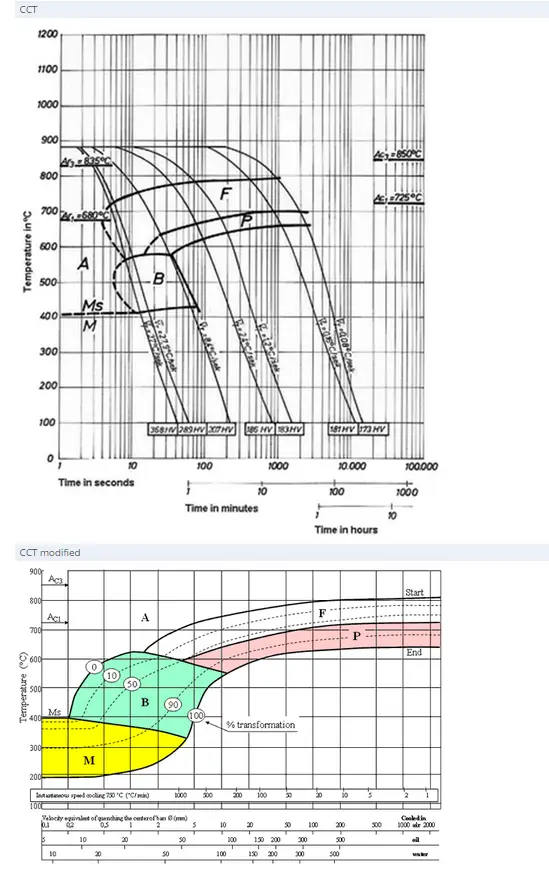Low and High temperature thermomechanical treatments
Abstract
Thermomechanical treatment combines heat application and deformation processes to simultaneously change alloy shape and refine microstructure. This comprehensive review examines low temperature thermomechanical treatment (LTMT), including ausforming and isoforming processes, alongside high temperature thermomechanical treatment (HTMT). The ausforming process involves deforming austenite in the metastable bay between ferrite and bainite curves, achieving dramatic strength increases up to 3000 MPa without compromising ductility. Industrial applications demonstrate significant improvements in strength-to-weight ratios for specialized steel components, particularly in aerospace and high-performance applications where cost considerations are secondary to performance requirements.
Understanding Thermomechanical Treatment Fundamentals
Thermomechanical treatment represents a sophisticated metallurgical approach that involves the simultaneous application of heat and deformation processes to alloys. This technique serves the dual purpose of changing material shape while refining the underlying microstructure. Hot-rolling of metals exemplifies this well-established industrial process, playing a crucial role in steel processing across various grades, from low carbon mild steels to highly alloyed stainless steel variants.
The traditional fabrication route begins with casting ingots that vary significantly in size, ranging from 1 to 50 tonnes. These ingots undergo soaking at extremely high temperatures between 1200-1300°C, followed by progressive hot rolling to produce billets, bars, and sheet materials. This process effectively breaks down the original coarse cast structure through repeated recrystallization of steel while maintaining the austenitic condition. Additionally, the gradual reduction of compositional inhomogeneities caused by casting segregation occurs during this treatment.
The thermomechanical treatment process also addresses inevitable non-metallic inclusions, including oxides, silicates, and sulphides. These inclusions become broken up, deformed, and distributed throughout the steel matrix in a more uniform manner, contributing to improved material properties and performance characteristics.
Low Temperature Thermomechanical Treatment - LTMT (Ausforming)
The ausforming process, also known as low temperature thermomechanical treatment (LTMT), involves the strategic deformation of austenite within the metastable bay located between the ferrite and bainite curves of the Time-Temperature-Transformation (TTT) diagram.

Figure 1: Schematic diagrams of thermochemical treatments a) ausforming-low temperature mechanical treatment; b) high temperature mechanical treatment; c) isoforming transformation.
The ausforming treatment process begins with steel containing a sufficiently developed metastable austenite bay being quenched from the austenitizing temperature to this specific region. Within this temperature range, substantial deformation occurs without allowing transformation to take place. The deformed steel subsequently transforms to martensite during quenching to room temperature, with the appropriate balance of mechanical properties achieved through subsequent tempering operations.
This ausforming treatment contrasts significantly with high temperature thermomechanical treatment (HTMT), where deformation occurs in the stable austenite region, typically above Ac3 temperature prior to quenching for martensite formation. A third process variation, isoforming, involves steel deformation in the metastable austenite region, but deformation continues until transformation completion at the intermediate temperature, allowing slow cooling to room temperature.
Critical Process Parameters for Ausforming Success
The ausforming process demands careful control for successful implementation and typically requires very substantial deformation levels. However, the significant attraction lies in the dramatic strength increases achieved with appropriate steels without adverse effects on ductility and toughness characteristics. For example, a steel composition containing 4.7% Cr, 1.5% Mo, 0.4% V, and 0.34% C demonstrates tensile strength of approximately 2000 MPa after conventional quenching and tempering, whereas ausforming treatment can achieve strengths exceeding 3000 MPa.
Steels exhibiting rapid austenite transformation at subcritical temperatures prove unsuitable for ausforming applications. The process necessitates adding alloying elements that develop a deep metastable austenite bay by displacing the TTT curve toward longer transformation times. The most beneficial elements include chromium, molybdenum, nickel, and manganese, with consideration for the fact that austenite deformation accelerates transformation kinetics.
Sufficient alloying element presence becomes necessary to slow reaction rates and prevent ferrite formation during cooling to the deformation temperature. The austenite grain size should remain as fine as possible, not only to increase dislocation density during deformation but also to minimize martensite plate size during quenching from the metastable austenite bay.
Temperature and Deformation Considerations
Cooling from the austenitizing temperature to the metastable bay must occur sufficiently rapidly to avoid ferrite formation. Following deformation, cooling should proceed fast enough to prevent bainite formation. The strength achieved through ausforming increases as deformation temperature decreases, presumably due to greater strain hardening induced in the austenite structure.
The selected temperature should remain low enough to avoid recovery and recrystallization while staying high enough to prevent bainite formation during deformation. Premature austenite decomposition has proven detrimental to mechanical properties, making temperature control critical for process success.
Deformation amount represents the most important variable in ausforming success. A roughly linear relationship exists between working degree and final strength achievement, with increases between 4 and 8 MPa per percent deformation. Significantly, many steels demonstrate actual ductility increases with increasing deformation, though this effect only becomes significant at deformations above 30% thickness reduction.
Microstructural Changes and Strengthening Mechanisms
Steels subjected to heavy deformation during ausforming exhibit extremely high dislocation densities, reaching up to 10¹³cm⁻². These dislocations form partially during deformation and partially during the shear transformation to martensite. The deformation typically occurs within the 500-600°C temperature range, where alloy carbide precipitation would be expected, making fine alloy carbide dispersions detectable through dark field electron microscopy.
During warm worked austenite transformation to martensite, at least part of the dislocation substructure, together with fine carbide dispersion, becomes inherited by the martensite structure. The martensite plate size demonstrates substantial reduction compared to similar steels receiving straight quenching from austenitizing temperature.
Multiple factors contribute to strength enhancement, as no single mechanism can fully account for the high strengthening degree observed. However, major contributions likely arise from very high dislocation density and fine alloy carbide dispersion associated with dislocations. Fine precipitate particles can act as dislocation multiplication centers during plastic deformation, further enhancing strengthening effects.
The martensitic transformation represents an essential strengthening process component, substantially increasing dislocation density and dividing each deformed austenite grain into numerous martensitic plates, significantly smaller than those in conventional heat treatments. These small plates likely inherit fine dislocation substructures from the deformed metastable austenite.
Isoforming Process Applications
The isoforming process involves metastable austenite deformation, but deformation continues until austenite transformation completion at the deformation temperature. This approach addresses the lamellar pearlite morphology that leads to low toughness in ferrite/pearlite steels, where the ductile/brittle transition temperature increases with larger pearlite volume fractions.
By applying deformation during phase transformation, instead of producing a ferrite/pearlite aggregate, the resulting structure consists of fine ferrite subgrains (approximately 0.5μm diameter) with spheroidized cementite particles (approximately 25nm diameter) primarily located at subgrain triple points.
Similar to ausforming steels, the chosen steel must possess a suitable TTT diagram. The process requires the ability to deform austenite prior to transformation, with transformation completion before deformation cessation. While only modest strength increases occur, substantial toughness improvements result from ferrite grain size refinement and lamellar cementite replacement with spheroidized particles.
For significant toughness gains, deformations exceeding 70% area reduction become necessary. Care must be taken to restrict deformation to temperatures where ferrite and pearlite reactions occur, as similar deformation in the bainitic region leads to marked toughness reductions.
High Temperature Thermomechanical Treatments (HTMT)
High temperature thermomechanical treatments involve deformation in the stable austenite range just above Ac3 temperature, enabling performance in steels lacking suitable metastable austenite bays. The steel undergoes quenching to the martensitic state followed by tempering at appropriate temperatures.
Strengthening achievement arises from austenite grain size refinement, typically reducing from 10-60 μm to 3 μm dimensions. Optimum properties often result when austenite recrystallization is avoided. Strong carbide forming elements prove beneficial, suggesting alloy carbide precipitation occurs in austenite during deformation.
A particular HTMT process advantage involves achieving optimum properties at modest deformations (approximately 40%), enabling deformation performance on existing equipment. While HTMT does not yield strengths as high as ausforming, ductility and fatigue properties typically prove superior.
HTMT represents a controlled rolling variant, normally applied to steels with higher alloying contents that can subsequently transform to martensite and undergo tempering treatments.
Industrial Steel Applications and Performance
Ausforming has produced some of the strongest, toughest steels developed to date, with the added advantage of excellent fatigue resistance characteristics. However, these steels typically require high concentrations of expensive alloying elements and must undergo large deformations, imposing heavy workloads on rolling mill equipment.
Nevertheless, these steels prove particularly valuable where high strength-to-weight ratios are required and cost considerations remain secondary factors. Typical applications include aircraft undercarriage components, specialized springs, and high-performance bolts requiring exceptional mechanical properties.
The 12% Cr transformable steels respond readily to ausforming, achieving tensile strengths exceeding 3000 MPa in appropriate compositions. A 0.4C-6Mn-3Cr-1.5Si steel composition has been ausformed to achieve 3400 MPa tensile strength, with improved ductility over conventional heat treatment approaches. Similar high strength levels with good ductility have been reported for 0.4C-5Cr-1.3Mo-1.0Si-0.5V steel compositions.
All these steel compositions contain sufficient alloying elements to allow adequate time for substantial deformation in the austenite bay of the TTT curve prior to transformation, making them ideal candidates for advanced thermomechanical treatment processes.
Trova all'istante migliaia di diagrammi di trattamento termico!
Total Materia Horizon contiene dettagli sul trattamento termico per centinaia di migliaia di materiali, diagrammi di temprabilità, indurimento e rinvenimento, diagrammi TTT e CCT, e molto altro.

Ottieni un account di prova GRATUITO su Total Materia Horizon e unisciti a una comunità di oltre 500.000 utenti provenienti da più di 120 paesi.